List of Korean flags
This is a list of flags used by South Korea, North Korea, and their predecessor states.
Korean reunification flag
| Flag | Date | Use | Description |
|---|---|---|---|

|
1991–present | Korean Unification Flag | Used to represent the whole of Korea when North and South participate together in international sporting events.[1] |
National
| Flag | Date | Use | Description |
|---|---|---|---|
| Present national flags of North and South Korea | |||

|
1948–present | Red field with a blue bar on the top and bottom and a star in the center known as the red flag. Current, post-1992 version shown. | |

|
1948–present | White field with a red and blue taegeuk in the center and four black trigrams, one in each corner of the flag. Current, post-2011 version shown. | |
| Historical versions | |||
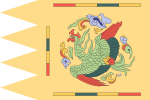
|
Extant 1392 | Also known as the "Bong-gi". | |

|
Extant 1392 | Also known as the "Haema-gi". | |

|
Extant 1392 | Also known as the "Sang-gi". | |

|
Extant 1856 | ||

|
Extant 1876 | ||

|
1882–1907 | ||

|
1897-1910 | ||
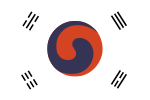
|
The third version from the top is depicted in the 1882 U.S. Navy book, Flags of Maritime Nations. Lowest is the version found in the 1944 United States postage stamp series. |
The former Korean imperial flag had a different taegeuk from that in the current South Korean flag. Note that the 1882 U.S. Navy depiction may be left-right reversed. The arrangement of the trigrams was not officially fixed until an ordinance of 1948, when the South Korean government was established. | |

| |||

| |||
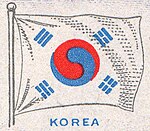
| |||

|
1919–1948 | In exile in Shanghai and Chungking located in China | |

|
1945–1946 | Used by the People's Committees throughout postwar Korea | |
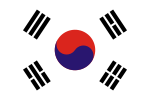
|
1946–1948 | Flag of the Provisional People's Committee for North Korea | A white rectangular background, a red and blue Taeguk in the center that symbolizes a balance, and four black trigrams, on each corner of the flag. |

|
1948–1992 | Flag of the Democratic People's Republic of Korea | Red field with a blue bar on the top and bottom and a star in the center known as the red flag |

|
August 15, 1948 – October 15, 1949 | Civil and state flag and ensign of the First Republic of South Korea. | This flag was designed by the first National Assembly. |

|
October 15, 1949 – October 1997 | Civil and state flag and ensign of South Korea | This flag was designed by the Ministry of Education and Culture in October 1949. The exact colors were not specified.[5] |

|
October 15, 1997 – May 2011 | Civil and state flag and ensign of the Sixth Republic of South Korea. | In October 1997, the South Korean government officially specified the exact colors to be used on the flag via presidential decree. |
North Korean government
| Flag | Date | Use | Description |
|---|---|---|---|
| Standard of the Chairman of the State Affairs Commission | |||

|
2018–present | Emblem of the Chairman of the State Affairs Commission on a dark red field. | |
| Political Organizations | |||

|
1949–present | Flag of the Workers' Party of Korea | Combination of a hammer (workers), a writing brush (intellectuals) and a Korean sickle (peasants), crossed over a red field. |

|
1946–present | Flag of the Socialist Patriotic Youth League | Emblem of Youth League on a red flag, with "Youth" (청년) on the emblem. |

|
1945–present | Flag of the Socialist Women's Union of Korea | Flag with the name of the organization: "Women's League" (녀성동맹). |

|
1955–present | Flag of the Korean Youth League in Japan | Tricolor flag with the League's logo. |
South Korean government
| Flag | Date | Use | Description |
|---|---|---|---|
| Presidential Standard | |||

|
1967–present | Two Phoenix taking golden Hibiscus syriacus under their wings. | |
| Standard of the Prime Minister | |||
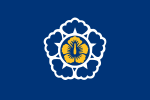
|
1988–present | Golden Hibiscus syriacus inlaid in symbolic Hibiscus syriacus insignia | |
| Flag of the National Government | |||

|
1988–2016 | Symbolic Hibiscus syriacus insignia, inlaid with the word 정부, or Government. | |
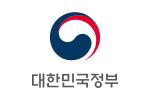
|
2016–present | Taeguk with the words "Republic of Korea Government" below. | |

|
2005–present | Flag of the South Korean national police agency. | |

|
2005–present | Flag of the South Korean coast guard | Insignia of the South Korean coast guard, with the words 해양경찰청 ("Maritime Police Agency") |
| Flag of the Committee for the Five Northern Korean Provinces | |||

|
1949–2016 | Symbolic Hibiscus syriacus insignia, covered by a blue arrow. | |
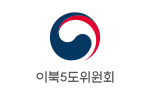
|
2016–present | Taeguk with the words "Committee for the Five Northern Korean Provinces" below. | |
| Political flags | |||
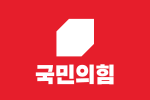
|
?–present | Flag of the People Power Party | |

|
?–present | Flag of the Justice Party | |
Military
| Flag | Date | Use | Description |
|---|---|---|---|
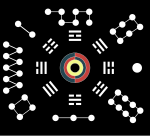
|
Shows a version of the Lo shu magic square. | ||

|
As one of the military flags of the Joseon Dynasty, it is called Sujagi (帥字旗) or Sugi (帥旗). During the Joseon Dynasty, it was hung as a mark of the general in the military camp. As for the shape, the symbol of longevity (帥) is engraved in black letters on the pressed color, and some have a dream (decoration of the flag) around the flag. | ||

|
4th century | A Simple Red Field. | |
| Late 5th Century | A Red Swallowtail Banner with a Yellow stripe. | ||
| Half 5th Century | A Black 4 Pointed Banner with 3 White Stripes. | ||

|
A Blue Field with a White Crescent Moon in the center. |
North Korea
| Flag | Date | Use | Description |
|---|---|---|---|
 |
1996–2002 | ||
 |
2002–2022 | The Supreme Commander Star on a red flag. Sometimes used as a war flag during military exercises. | |

|
1948 | Initially designed in 1948 with the Emblem of North Korea in 1948. The slogan reads: "For the unification and independence of the motherland and the people" (조국의 통립과 인민을 위하여). Used only as ceremonial unit color for historical units beginning 2013. | |

|
1948–1961 | Used only as ceremonial unit color especially for Guards units beginning 2013. | |

|
1961–1992[6] | Latest version shown; emblem adopted in 1992. [7] The slogan reads: "For the unification and independence of the motherland, and the freedom and happiness of the people" (조국의 통일, 독립과 인민의 자유와 행복을 위하여). | |

|
1992–1993 | Emblem of DPRK updated to the one featuring the Paektu Mountain. | |

|
1948–1993 | With a red star with golden border and bearing a hammer and two sickles. | |

|
1948–1961 | Guards badge with Korean letters reading "[Unit number] / 2nd (as in ceremonies) Infantry Division" (제2부병사단). Used only as ceremonial unit color for Guards units beginning 2013. | |

|
1993–present | Emblem of KPA with slogan: "For the unification and independence of the motherland, and the freedom and happiness of the people" (조국의 통일, 독립과 인민의 자유와 행복을 위하여).[8]
The 4.25 commemorates the foundation of People's Anti-Japanese Guerrilla Army on April 25, 1932.[8] Also used since 2020 by the Special Operations and Strategic Forces as branch and unit colours. | |

|
?–present | Reverse side of the flag of the Korean People's Army Ground Force. | With Korean letters reading "Revolutionary armed forces of the Workers' Party of Korea, Korean People's Army [unit name] / No.425 unit (in ceremonies)" (조선로동당의 혁명적무장력인 조선인민군 제425 군부대).
The number 425 commemorates the foundation of People's Anti-Japanese Guerrilla Army on April 25, 1932. |

|
1993–present | Emblem of KPA with anchor. | |

|
?–present | Reverse side of the flag of the flag of Korean People's Navy. | With Korean letters reading "Revolutionary armed forces of the Workers' Party of Korea, Korean People's Army [unit name] / No.415 unit (in ceremonies)" (조선로동당의 혁명적무장력인 조선인민군 제415 군부대).
The number 415 commemorates the birthday of Kim Il-Sung on April 15. |

|
1990s–present | Red flag with Paektu Mountain in rays in a disc with national color outlines and a red star. | |
| File:Guards ensign of North Korea.svg | 1990s–present | ||

|
1990s–present | ||

|
1993–present | Emblem of KPA with wings. | |

|
?–present | Reverse side of the flag of the Korean People's Air Force. | With Korean letters reading "Revolutionary armed forces of the Workers' Party of Korea, Korean People's Army [unit name] / No.216 unit (in ceremonies)" (조선로동당의 혁명적무장력인 조선인민군 제216 군부대).
The number 216 commemorates the birthday of Kim Jong-Il on February 16. |

|
2018–2020 | Emblem of KPA on an upper half globe | |

|
?–present
(First appearance in 2018) |
Reverse side of the flag of the flag of the Korean People's Army Strategic Force. | With Korean letters reading "Revolutionary armed forces of the Workers' Party of Korea, Korean People's Army [unit name] / No.108 unit (in ceremonies)" (조선로동당의 혁명적무장력인 조선인민군 제108 군부대).
The number 108 commemorates the birthday of Kim Jong-Un on January 8. |

|
2018–2020 | Emblem of KPA with the Big Dipper. | |

|
?–present
(First appearance in 2018) |
Reverse side of the flag of the flag of the Korean People's Army Special Operation Force. | With Korean letters reading "Revolutionary armed forces of the Workers' Party of Korea, Korean People's Army [unit name]". / No.506 unit (in ceremonies)" (조선로동당의 혁명적무장력인 조선인민군 제506 군부대).
The number 506 commemorates the 7th Congress of the Worker's Party of Korea on May 6, 2016. |

|
2007–present | Flag of the Worker-Peasant Red Guards | Slogan used until 2012, since then the flag shares the same motto as the rest of the KPA. |

|
?–present | Reverse side of the flag of the Worker-Peasant Red Guards | With Korean letters reading "Worker-Peasant Red Guards". |
South Korea
| Flag | Date | Use | Description |
|---|---|---|---|

|
1948–present | Insignia of the armed forces on a red field. | |
| File:Flag of the Minister of National Defense.svg | ?–present | ||
| File:Flag of the Deputy Minister of National Defense.png | ?–present | ||

|
?–present | ||

|
1946–present | Insignia of the army on a field parted per fess; above is white, below is blue. | |

|
?–present | ||

|
?–present | ||

|
?–present | ||

|
?–present | ||

|
?–present | ||

|
1955–present | Naval ensign, navy flag, and naval jack | Taegeuk on crossed anchors in a white canton on a blue field |

|
?–present | ||

|
?–present | ||

|
?–present | ||

|
?–present | ||

|
?–present | ||

|
1952–present | The similarity with the flag of the United States Marine Corps shows the strong influence of the United States since the creation of South Korean armed forces. | |

|
?–present | ||

|
?–present | ||

|
?–present | ||

|
?–present | ||

|
1952–present | It is also used as the flag of the Air Force | |

|
?–present | ||

|
?–present | ||

|
?–present | ||

|
?–present | ||

|
?–present | ||

|
1968–present | Flag of the Republic of Korea Reserve Forces |
See also
References
- ^ Myers, Brian Reynolds (7 February 2018). "On the February 8 Parade and the Olympics". Sthele Press. Retrieved 9 February 2018.
By forbearing to march behind the yin-yang flag at the opening ceremony of the Olympics, the South Korean athletes are making a bigger sacrifice than the North Koreans... [T]he peninsula flag means two very different things to the two Koreas. In the South it symbolizes a desire for peaceful co-existence, or at most for a unification of equal partners in the reassuringly remote future. In wall posters above the DMZ it has always symbolized the southern masses' yearning for "autonomous unification," meaning absorption by the North. It's worrying to think how inner-track propaganda is certain to misrepresent the South Koreans' eschewal of their state flag for this of all symbols — and at this of all events.
- ^ 봉기(鳳旗) (in Korean). War Memorial of Korea. Archived from the original on 2 February 2017. Retrieved 15 November 2021.
- ^ a b "History of the South Korean flag". www.crwflags.com.
- ^ a b c Kariyasu, Nozomi (July 2009). The History of Taegeuk Flags [of South Korea] (PDF). 23rd International Congress of Vexillology. Yokohama, Japan: International Federation of Vexillological Associations.
- ^ "Ministry of Education Notice No. 2". Official Gazette. 15 October 1949. Retrieved 18 January 2022.
- ^ Tertitskiy, Fyodor (10 April 2018). "What North Korea's army flags can teach us about its recent history". NK News. Retrieved 9 September 2018.
- ^ Tertitskiy, Fyodor (10 April 2018). "What North Korea's army flags can teach us about its recent history". NK News. Retrieved 9 September 2018.
- ^ a b Tertitskiy, Fyodor (10 April 2018). "What North Korea's army flags can teach us about its recent history". NK News. Retrieved 9 September 2018.
